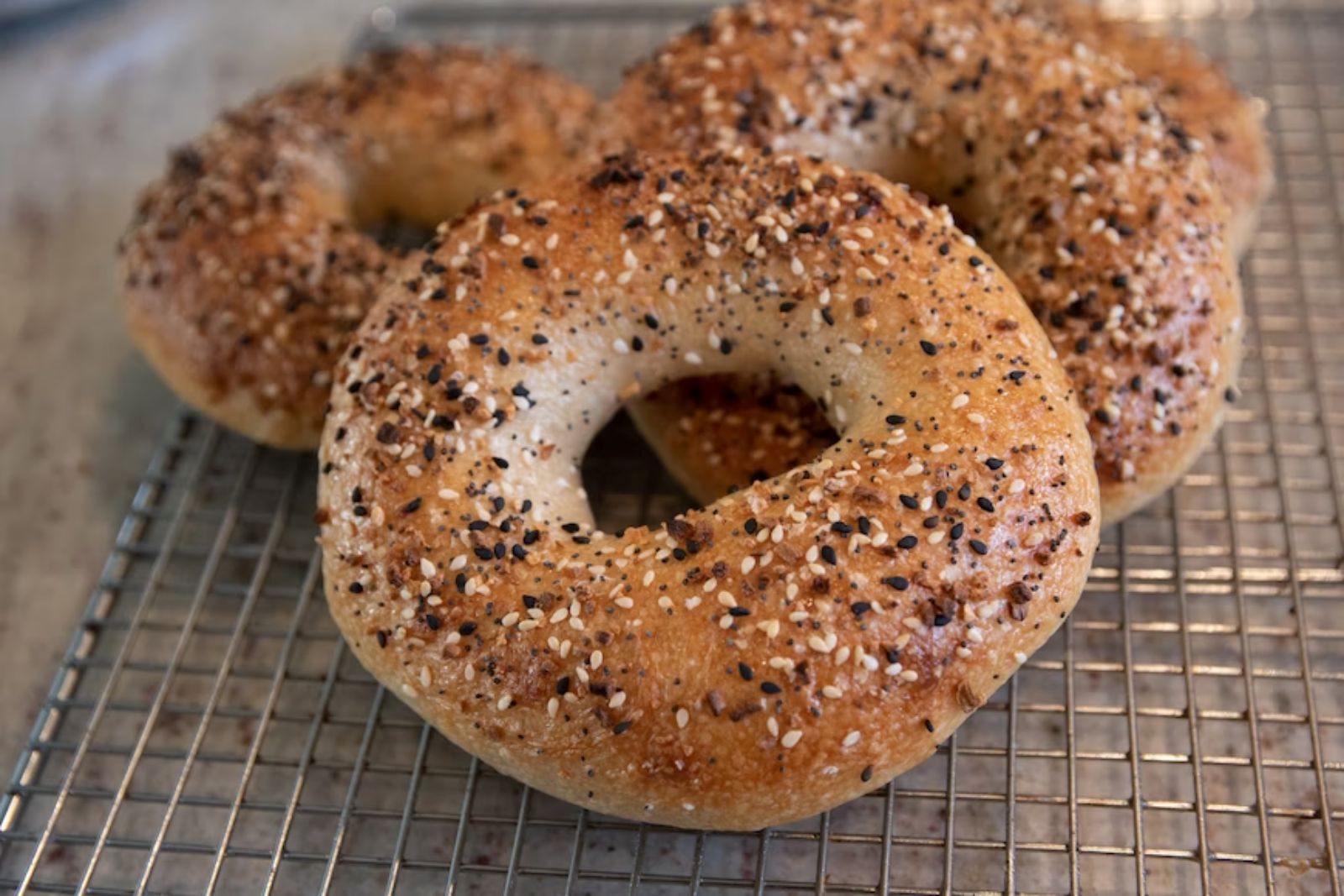
Bagels are a type of bread product that originated in Jewish communities and have become popular worldwide. They are typically shaped like a ring or a doughnut and have a dense, chewy texture. Bagels have a distinct flavor and are often boiled before baking, which gives them a unique crust and a soft interior. Freezing bagels is a convenient way to ensure you always have a tasty breakfast option available. Whether you have an excess of freshly baked bagels or want to stock up for future cravings, proper freezing techniques can help preserve their texture and flavor. By following a few simple steps, you can freeze bagels effectively, preventing them from becoming stale or losing their quality.
Here are the steps to freeze bagels:
Step 1: Allow the bagels to cool completely
Allowing the bagels to cool completely before freezing is an important step to maintain their quality during storage. When bagels come out of the oven, they are still warm and retain some residual moisture. If you place warm bagels directly into packaging for freezing, the trapped heat and moisture can create condensation inside the packaging.
Condensation can have negative effects on the texture and taste of the bagels when they are thawed. It can lead to sogginess, loss of crispness, and even freezer burn. Freezer burn occurs when moisture on the surface of the bagel evaporates and then refreezes, causing dehydration and a dry, off-flavor.
By allowing the bagels to cool completely to room temperature before freezing, you give them time to release excess heat and moisture. Placing them on a wire rack allows air to circulate around the bagels, facilitating the cooling process. This step helps prevent the formation of condensation and promotes the maintenance of the bagels’ texture and flavor during freezing.
It’s important to note that freezing warm bagels can also result in the formation of ice crystals, which can negatively impact their quality. Ice crystals can cause structural damage to the dough, resulting in a less desirable texture when thawed.
Step 2: Decide on portion sizes
Deciding on portion sizes before freezing bagels allows for greater convenience and flexibility when it comes to enjoying them later. Whether you prefer to freeze whole bagels or divide them into smaller portions depends on your personal preference and how you plan to consume them.
Freezing whole bagels is a suitable option if you typically consume an entire bagel in one sitting or if you have specific plans for using them, such as making sandwiches or bagel pizzas. It maintains the bagel’s original shape and size, requiring minimal preparation before consumption.
On the other hand, dividing bagels into smaller portions can be advantageous in terms of convenience and versatility. By cutting the bagels in half or into individual slices, you create pre-portioned servings that are easy to grab and thaw when you want a quick breakfast or snack. This is especially helpful if you prefer to enjoy bagels in smaller portions or if you want to have more control over portion sizes.
Dividing bagels into portions also allows for greater flexibility in terms of flavor and toppings. For example, you can freeze a variety of bagel flavors and have options readily available based on your mood or preference. Additionally, having pre-sliced bagel portions can make it easier to add spreads or fillings, such as cream cheese or sandwich ingredients, without the need for additional preparation.
Should I slice the bagels before or after freezing them?
It is generally recommended to slice the bagels before freezing them. Slicing the bagels before freezing allows for easier portioning and individual servings when thawing. Additionally, it facilitates quicker and more even thawing since the surface area of the sliced bagels is increased, promoting efficient heat transfer during the thawing process.
Step 3: Wrap each bagel tightly in plastic wrap
Wrapping each bagel tightly in plastic wrap is a crucial step in the freezing process to protect the bagels from freezer burn and maintain their freshness and texture. Here’s why this step is important:
- Prevention of freezer burn: Freezer burn occurs when the surface of the food comes into contact with air, leading to moisture loss and oxidation. It can result in dry, discolored patches and negatively impact the taste and texture of the bagels. By tightly wrapping the bagels in plastic wrap, you create a barrier that helps prevent air from reaching the surface of the bagels. This reduces the risk of freezer burn and helps maintain their quality during freezing.
- Preservation of moisture: Bagels have a dense and chewy texture that depends on their moisture content. When exposed to the dry air in the freezer, bagels can lose moisture and become dry and stale. Wrapping them tightly in plastic wrap helps retain the bagels’ moisture, preventing them from drying out and maintaining their desirable texture when thawed.
- Protection from odors and flavors: The plastic wrap creates an additional layer of protection, preventing the bagels from absorbing odors or flavors from other foods in the freezer. This ensures that the bagels retain their original taste and aroma, allowing you to enjoy them without any unwanted influences from neighboring frozen items.
- Easy portion control: Individually wrapping each bagel in plastic wrap allows for easy portion control. If you decide to freeze the bagels in smaller portions, the individual wrapping makes it convenient to separate and thaw only the desired number of bagels without having to defrost the entire batch.
When wrapping the bagels, ensure that the plastic wrap covers the entire surface of each bagel and create a tight seal. This helps to minimize air exposure and maximize the preservation of freshness and texture during freezing.
Step 4: Double-wrap the bagels in aluminum foil
Double-wrapping the bagels in aluminum foil after the initial plastic wrap provides an extra layer of protection and further enhances their preservation during freezing. Here’s why this step is beneficial:
- Enhanced protection against freezer burn: Aluminum foil is an excellent barrier against air and moisture. By adding a second layer of wrapping with aluminum foil, you create an additional shield that helps prevent the bagels from developing freezer burn. This is particularly important if the bagels will be stored in the freezer for an extended period.
- Improved moisture retention: Bagels’ texture and taste rely on their moisture content. The double layer of wrapping with aluminum foil helps seal in the bagels’ moisture, reducing the risk of them drying out during freezing. It provides an added level of insulation that helps maintain the bagels’ desirable chewiness and prevents them from becoming stale.
- Protection from freezer odors and flavors: Aluminum foil acts as a barrier against odors and flavors present in the freezer. It helps safeguard the bagels’ original taste and aroma, ensuring that they retain their distinct flavor profile when thawed. This is particularly beneficial if there are strong-smelling foods stored in the freezer that could potentially transfer unwanted odors to the bagels.
- Added structural support: Bagels are relatively dense and have a distinct shape. The aluminum foil wrap provides structural support, helping to maintain the bagels’ shape and preventing them from getting squished or distorted during freezing.
When double-wrapping the bagels in aluminum foil, ensure that the entire surface of each bagel is covered. This includes the top, bottom, and sides of the bagels, creating a tight and secure wrap.
Can I freeze bagels without aluminum foil?
Yes, you can freeze bagels without using aluminum foil. While aluminum foil provides an extra layer of protection against freezer burn, it is not a requirement. You can wrap the bagels tightly in plastic wrap or place them in a freezer-safe bag or container to maintain their freshness and prevent freezer burn.
Step 5: Label and date the package
Labeling and dating the package when freezing bagels is essential for organization and optimal freshness. Here’s why this step is important:
- Easy identification: Freezing bagels often involves storing multiple packages in the freezer. By labeling each package, you can easily identify the contents without having to open and inspect them. This saves time and prevents unnecessary thawing of bagels you may not want to consume at that moment. Clear labeling allows you to quickly locate the desired bagels and make informed decisions based on your preferences.
- Tracking freshness: Bagels, like any other food item, have a limited shelf life even when frozen. By dating the package, you establish a reference point to track how long the bagels have been in the freezer. This information helps you prioritize consumption, ensuring that you enjoy the bagels within their recommended storage time frame for optimal taste and quality.
- Avoiding food waste: Accurately dating the package allows you to keep track of the bagels’ age and helps prevent unnecessary food waste. By knowing when the bagels were frozen, you can make informed choices about their consumption and prioritize the older packages to ensure they are consumed before newer ones. This reduces the chances of forgetting about frozen bagels, leading to potential spoilage and wasted food.
- Rotation and freshness maintenance: Properly labeled packages enable a rotation system, ensuring that older bagels are used first. This practice helps maintain freshness, as bagels frozen for a shorter period will retain their quality for a longer time. By consuming the oldest bagels first, you maximize their taste and texture, avoiding any potential decline in quality that may occur over time.
When labeling the package, include information such as the contents (e.g., plain bagels, cinnamon-raisin bagels) and the date of freezing. You can use adhesive labels, permanent markers, or freezer-safe tape to mark the information clearly on the package.
Step 6: Store the wrapped bagels in the freezer
Storing the wrapped bagels properly in the freezer is the final step in the process of freezing bagels. Here’s why this step is important:
- Protection from freezer burn: Placing the wrapped bagels in a freezer-safe bag or airtight container provides an extra layer of protection against freezer burn. It helps to further insulate the bagels from air and moisture, reducing the risk of freezer burn and maintaining their freshness and quality.
- Preventing cross-contamination: Storing the bagels in a separate bag or container helps prevent cross-contamination with other items in the freezer. This is particularly important if you have strongly flavored or aromatic foods stored nearby. By keeping the bagels isolated, you preserve their original taste and prevent them from absorbing unwanted flavors or odors.
- Organization and space efficiency: Using a freezer-safe bag or container allows for better organization in the freezer. It keeps the bagels contained in one place, making it easier to locate and access them when needed. Moreover, using a bag or container that is appropriately sized for the bagels helps optimize freezer space and prevents them from getting crushed or damaged by other items.
- Maintenance of quality and texture: Storing the bagels in the freezer at a temperature of 0°F (-18°C) or below helps maintain their quality and texture for an extended period. Freezing at these temperatures slows down the deterioration of the bagels, preserving their freshness, taste, and chewy texture. It also inhibits the growth of microorganisms, ensuring food safety.
When placing the wrapped bagels in a bag or container, ensure that it is sealed tightly to prevent air from entering. Squeeze out as much air as possible before sealing to minimize the potential for freezer burn. Additionally, choose a spot in the freezer where the bagels won’t be crushed or damaged by other items, such as on a flat shelf or in a designated freezer compartment.
Other related questions
How long can bagels last in the freezer?
Bagels can last in the freezer for up to 3 months without significant loss in quality. When properly stored in airtight packaging at a temperature of 0°F (-18°C) or below, they can retain their freshness, taste, and texture. However, it’s advisable to consume them within the first 1 to 2 months for the best flavor and overall experience.
How do I defrost bagels?
To defrost bagels, remove them from the freezer and unwrap them from their packaging. Place the frozen bagels on a plate or baking sheet and let them thaw at room temperature for approximately 1 to 2 hours. Alternatively, you can preheat your oven to a low temperature (around 200°F or 95°C), wrap the bagels in aluminum foil, and warm them in the oven for 10 to 15 minutes for a quicker defrosting method.
Can I refreeze bagels?
It is generally not recommended to refreeze bagels once they have been thawed. The repeated freezing and thawing process can affect the quality and texture of the bagels, resulting in a less desirable eating experience. To maintain the best taste and texture, it is advisable to consume the thawed bagels within a reasonable time frame and avoid refreezing them.
How do I know if the bagels have gone bad after being frozen?
After being frozen, if bagels develop an off odor, unusual taste, or visible signs of spoilage such as mold or excessive freezer burn, they may have gone bad. Additionally, if the texture of the bagels becomes excessively dry, mushy, or gritty, it is an indication of potential spoilage. It is important to use your senses and inspect the bagels carefully before consuming them to ensure they are still safe to eat.
Can I freeze flavored or specialty bagels?
Absolutely! Flavored or specialty bagels can also be frozen. Whether they are cinnamon-raisin, blueberry, or any other variety, the freezing process remains the same. Just ensure they are properly wrapped and labeled to maintain their unique flavors.
Can I freeze store-bought or pre-packaged bagels?
Yes, you can freeze store-bought or pre-packaged bagels. They often come in convenient packaging, but it’s still recommended to transfer them to airtight wrap or containers for better protection against freezer burn. Freezing store-bought bagels is an excellent way to extend their shelf life and have them readily available when needed.
Can I freeze homemade bagels that contain toppings or glaze?
Yes, you can freeze homemade bagels that contain toppings or glaze. However, it’s recommended to freeze them before applying the toppings or glaze. Simply freeze the plain baked bagels, and when you’re ready to enjoy them, you can add the desired toppings or glaze after thawing or toasting.
Can I freeze homemade bagels that have cream cheese or other spreads already added?
It is not recommended to freeze homemade bagels that already have cream cheese or other spreads added. Cream cheese and similar spreads do not freeze well and can result in a change in texture and separation upon thawing. It is best to freeze the plain bagels and add the desired spreads after thawing to maintain the quality and consistency of both the bagels and the spreads.
Are there any special considerations for gluten-free or vegan bagels when freezing them?
When freezing gluten-free bagels, it is important to ensure they are well-wrapped to prevent moisture loss and maintain their texture. Gluten-free bagels can be more delicate, so handle them with care during freezing and thawing to avoid breakage. Similarly, for vegan bagels, proper wrapping and storage are essential to preserve their moisture and prevent any flavor changes. Always check the specific instructions or recommendations provided by the manufacturer or recipe source for the best practices when freezing gluten-free or vegan bagels.
Can I freeze bagels that have been flavored with herbs or spices?
Yes, you can freeze bagels that have been flavored with herbs or spices. The freezing process does not significantly affect the flavors of herbs or spices. Follow the standard steps of allowing the bagels to cool, wrapping them tightly, and storing them in the freezer to maintain their freshness and taste.








